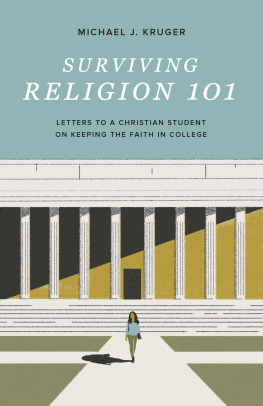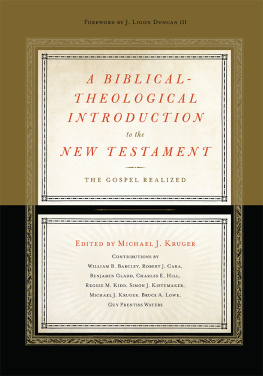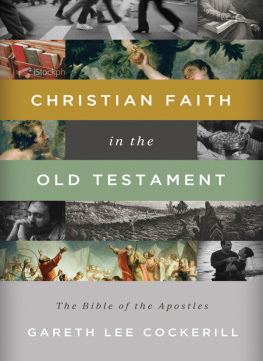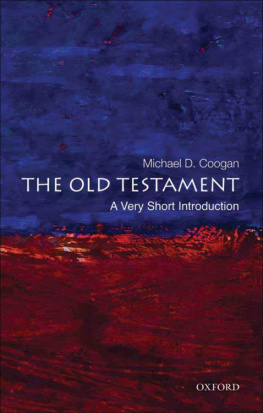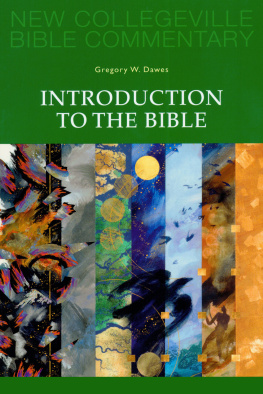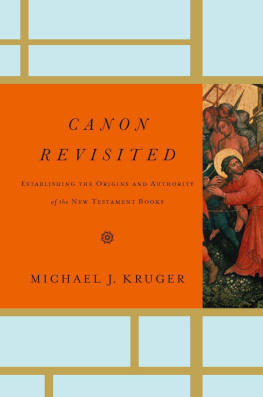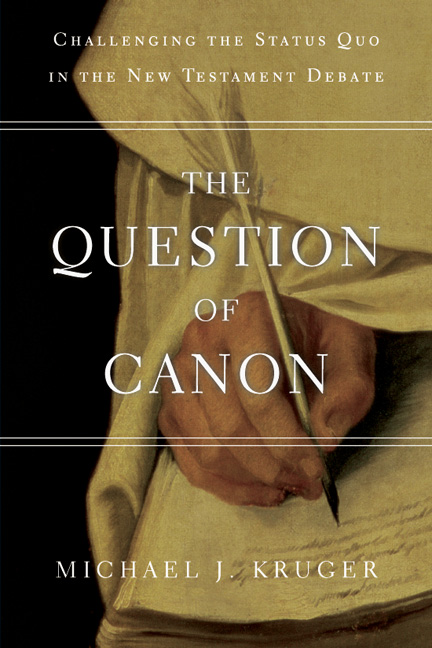InterVarsity Press
P.O. Box 1400,
Downers Grove, IL 60515-1426
World Wide Web: www.ivpress.com
Email:
2013 by Michael J. Kruger
All rights reserved. No part of this book may be reproduced in any form without written permission from InterVarsity Press.
InterVarsity Press is the book-publishing division of InterVarsity Christian Fellowship/US A , a movement of students and faculty active on campus at hundreds of universities, colleges and schools of nursing in the United States of America, and a member movement of the International Fellowship of Evangelical Students. For information about local and regional activities, write Public Relations Dept., InterVarsity Christian Fellowship/USA, 6400 Schroeder Rd., P.O. Box 7895, Madison, WI 53707-7895, or visit the IVCF website at www.intervarsity.org .
Chapter one of this book was published in a slighty different form as The Definition of the Term Canon: Exclusive or Multi-Dimensional? Tyndale Bulletin 63 (2012): 1-20. Permission to republish courtesy of Tyndale Bulletin.
Scripture quotations, unless otherwise noted, are from The Holy Bible, English Standard Version, copyright 2001 by Crossway Bibles, a division of Good News Publishers. Used by permission. All rights reserved.
While all stories in this book are true, some names and identifying information in this book have been changed to protect the privacy of the individuals involved.
Cover design: Cindy Kiple
Image: Brother Pedro Machado by Francisco de Zurburan at Real Academia de Bellas Artes de San Fernando, Madrid, Spain. Giraudon / The Bridgeman Art Library
ISBN 978-0-8308-6497-3 (digital)
ISBN 978-0-8308-4031-1 (print)
Contents
Must We Make a Sharp Distinction Between the Definitions of Canon and Scripture ?
Was There Really Nothing in Early Christianity That May Have Led to a Canon?
Were Early Christians Averse to Written Documents?
Were the New Testament Authors Unaware of Their Own Authority?
Were the New Testament Books First Regarded as Scripture at the End of the Second Century?
Preface

F or many years now, the topic of the New Testament canon has been the main focus of my research and writing. It is an exciting field of study that probes into questions that have long fascinated scholars and laypeople alike, namely when and how these twenty-seven books came to be regarded as a new scriptural deposit. But the story of the New Testament canon is bigger than just the when and the how . It is also, and perhaps most fundamentally, about the why . Why did Christians have a canon at all? Does the canon exist because of some later decision or action of the second- or third-century church? Or did it arise more naturally from within the early Christian faith itself? Was the canon an extrinsic phenomenon or an intrinsic one? These are the questions this book is designed to address. And these are not micro questions but macro ones. They address foundational and paradigmatic issues about the way we view the canon. They force us to consider the larger framework through which we conduct our researchwhether we realized we had such a framework or not.
Of course, we are not the first to ask such questions about why we have a canon. Indeed, for many scholars this question has already been settled. The dominant view today, as we shall see below, is that the New Testament is an extrinsic phenomenon: a later ecclesiastical development imposed on books originally written for another purpose. This is the framework through which much of modern scholarship operates. And it is the goal of this volume to ask whether it is a compelling one. To be sure, it is no easy task challenging the status quo in any academic field. But we should not be afraid to ask tough questions. Likewise, the consensus position should not be afraid for them to be asked.
In any project like this one, there are many people and institutions that deserve thanks. I am grateful for the support of Dan Reid at IVP Academic for his keen interest in this project. It has been a pleasure to work with him and all the folks at InterVarsity Press. Although chapter one below was originally written for this volume, it was published last year (in a slightly different form) in Tyndale Bulletin 63 (2012): 1-20, under the title The Definition of the Term Canon: Exclusive or Multi-Dimensional? Thanks to Tyndale Bulletin for permission to republish it here. I am grateful for the many colleagues who have given feedback and input to this book, including Larry Hurtado, Paul Foster, Chris Keith and Don Hagner. It is a better volume as a result of their thoughtful comments, though its shortcomings are still my own. My teaching assistants, Alan Gay and Aaron Gray, also deserve a word of thanks. Their tireless attention to detail was a great help to me as this book was edited. Most of all, I would like to thank my wife, Melissa, and my three children, Emma, John and Kate. They are always a joy to my heart when I return home from a long day of writing books such as this one.
Abbreviations
Apocrypha and Septuagint
| Bar | Baruch |
| 1-2 Macc | 1-2 Maccabees |
| Sir | Sirach |
| Tob | Tobit |
| Wis | Wisdom of Solomon |
Old Testament Pseudepigrapha
| 1 En. | 1 Enoch |
| 2 En. | 2 Enoch |
| 2 Bar. | 2 Baruch |
| Apoc. Ab. | Apocalypse of Abraham |
| Jub | Jubilees |
| T. Mos. | Testament of Moses |
Dead Sea Scrolls
| 1QH a | 1QHodayot a |
| 1QM | 1QWar Scroll |
| 1QpHab | 1QPesher to Habakkuk |
| 1QS | 1QRule of the Community |
| 1QSa | 1QRule of the Congregation |
| 1QSb | 1QRule of Benedictions |
| 4Q52 | 4QSamuel b |
| 4Q175 | 4QTestimonia |
| 4Q504 | 4QWords of the Luminaries a |
| 4QMMT c | 4QHalakhic Letter c |
| 11Q13 | 11QMelchizedek |
| 11QT a | 11QTemple a |
| CD | Damascus Document |
Tractates in the Mishnah, Tosefta and Talmud
| b. Meg. | Babylonian Talmud Megillah |
| b. Soah | Babylonian Talmud Soah |
| m. Kelim | Mishnah Kelim |
Apostolic Fathers
| 1 Clem. | 1 Clement |
| 2 Clem | 2 Clement |
| Barn. | Epistle of Barnabas |
| Did. | Didache |
| Herm. Vis. | Shepherd of Hermas, Vision(s) |
| Ign. Eph. | Ignatius, To the Ephesians |
| Ign. Magn. | Ignatius, To the Magnesians |
| Ign. Phld. | Ignatius, To the Philadelphians |
| Ign. Pol. | Ignatius, To Polycarp |
| Ign. Smyrn. | Ignatius, To the Smyrnaeans |
| Ign. Rom. | Ignatius, To the Romans |
| Polycarp |
| Phil. | To the Philippians |
Greek and Latin Works
| Cicero |
| Tusc. | Tusculanae disputationes |
| Clement of Alexandria |
| Exc. | Excerpta ex Theodoto (Excerps from Theodotus) |
| Strom. | Stromata (Miscellanies) |
| Eusebius |


